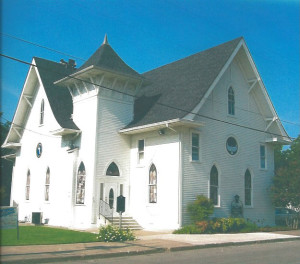Occasionally I find myself with great materials that are too brief to incorporate into a whole article. Today is one of those articles where I try to include a few different topics in this space.

The lovely Methodist Church in Lone Oak. This structure was completed in 1889. (Photo courtesy of Rev. Lowe, pastor of the church.)
The first item involves the Lone Oak Methodist Church that will celebrate its 160th Anniversary on Sunday, November 2, 2014. In 1854 eleven charter members gathered in a private home at Sabine Forks with the intent of creating a new Methodist Episcopal Church South in Hunt County. No need to look for Sabine Forks on a map; it is under Lake Tawakoni today. Four years later, the community of Lone Oak was chosen as a permanent site for the small band. After meeting in a schoolhouse until 1871, the congregation joined forces with the Lone Oak Masonic Lodge to build a two-story square building with stairs on one outer wall leading to the second floor. The Masons met upstairs and the Methodists met downstairs. This was a common arrangement on the American frontier.
Not only did the Methodists use the Masonic Lodge for worship, but also several other denominations followed suit until that structure burned in 1884. A new site was purchased on Main Street where the present vernacular Gothic Revival structure featuring twin bracketed towers and lancet windows opened its doors in 1889. Originally lighted with kerosene lamps and heated with wood burning stoves, the town and church had electricity by 1914-1915 and water in 1925. Stained glass windows were installed in 1971. For its centennial the church was completely renovated and modernized in 1986-1987.
I am aware that this is not an appropriate time to introduce the next topic but here goes. At the end of October 1914 the Greenville High School football team had not lost a game. Not only that, they had not been scored on. Three young men from Greenville played on the Texas A&M College football team. Football was a really big deal around town.
Public school football was completely different than it is today. Not only were the uniforms and protective gear completely deficient, the rules of the game varied. Greenville’s green jerseys were abandoned in 1917 because of World War I. Green dye was a wartime commodity and reserved only for the Army.
The University Interscholastic League (UIL) did not come into being until 1917. Teams made up their own schedules, usually with other nearby schools. In 1919 Greenville High School was again a powerhouse that claimed the state championship without the blessings of UIL. We won’t mention football and Greenville in the same breath over the last few years.
